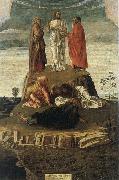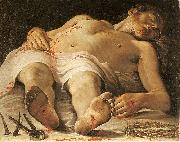Wholesale Oil Painting Reproductions No Minimum and Door to Door! |
|||||||||||
|
|
|||||||||||

|
|||||||||||
|
|
|
||||||||
All Philippe de Champaigne Oil Paintings |
||||||||
|
|
||||||||
|
|
||||||||
|
Artist Introduction: 1602-1674
Philippe de Champaigne Locations
His artistic style was varied: far from being limited to the realism traditionally associated with Flemish painters, it developed from late Mannerism to the powerful lyricism of the Baroque. It was influenced as much by Rubens as by Vouet, culminating in an aesthetic vision of the world and of humanity that was based on an analytic view of appearances and on psychological truth. He was perhaps the greatest portrait painter of 17th-century France. At the same time he was one of the principal instigators of the Classical tendency and a founder-member of the Acadmie Royale de Peinture et de Sculpture. His growing commitment to the Jansenist religious movement (see JANSENISM) and the severe plainness of the works that it inspired has led to his being sometimes considered to typify Jansenist thinking, with its iconoclastic impulse, in spite of the opposing evidence of his other paintings. He should be seen as an example of the successful integration of foreign elements into French culture and as the representative of the most intellectual current of French painting. |
||||||||
|
|
||||||||
|
The Dead Christ Painting ID:: 379 |
Musee du Louvre, Paris |
|||||||
Height Width |
INS/CM Quality |
|||||||
|
X |
| |||||||
|
|
||||||||
All Antonello da Messina Oil Paintings |
||||||||
|
|
||||||||
|
|
||||||||
|
Artist Introduction: 1430-1479
Italian
Antonello da Messina Galleries
Antonello was born at Messina around 1429-1431, to Giovanni de Antonio Mazonus and Garita (Margherita). He was probably apprenticed in his native city and in Palermo.
Around the year 1450, according to a 1524 letter of the Neapolitan humanist Pietro Summonte,[1] he was a pupil of the painter Niccol?? Colantonio at Naples, then one of the most active centres of Renaissance arts.
Around 1455 he painted the so-called Sibiu Crucifixion, which was inspired by the Flemish Calvaries and is housed in the Muzeul de Art?? in Bucharest. Of the same years is the Crucifixion in the Royal Museum of Antwerp: his early works shows a marked Flemish influence, which it is now understood he derived from his master Colantonio and from works by Rogier van der Weyden and Jan van Eyck that belonged to Colantonio's patron, Alfonso V of Aragon; his biographer Vasari remarked that Antonello saw at Naples an oil painting by Jan Van Eyck (the "Lomellini Tryptych") belonging to King Alphonso of Aragon; Vasari's further narrative, that being struck by the new method, set out for The Netherlands to acquire a knowledge of the process from Van Eyck's disciples is discredited today. Another theory, supported only by vague documentary evidence, suggests that in 1456 Antonello visited Milan, where he might have met Van Eyck's most accomplished follower, Petrus Christus. Since Antonello was one of the first Italians to master Eyckian oil painting, and Christus was the first Netherlandish painter to learn Italian linear perspective, their meeting is a tempting answer to both questions. But in fact, neither artist is known for certain to have been in Milan at the time.
The following year, Antonello received his first commission as an independent artist, a banner for the Confraternit?? di San Michele dei Gerbini in Reggio Calabria. At this date, he was already married, and his son Jacobello had been born.
In 1460, his father is mentioned leasing a brigantine to bring back Antonello and his family from Amaltea, a town in Calabria. In that year, Antonello painted the so-called Salting Madonna, in which standard iconography and Flemish style are backed by a greater attention in the volumetric proportions of the figures, probably coming from his knowledge of some works by Piero della Francesca. Also from around 1460 are the two small panels depicting Abraham Served by the Angels and St. Jerome Penitent now in the Museo Nazionale della Magna Grecia in Reggio Calabria. In 1461 his younger brother Giordano entered Antonello's workshop, signing a three-years' contract. Of that year is a Madonna with Child for the Messinese nobleman Giovanni Mirulla, now lost.
Between 1465-1470, Antonello finished a Portrait of a Man now at Cefal??. His portraits are noteworthy for his characteristic use of the three-quarter view, typical of the Flemish School, whereas almost all Italian painters adopted the medal profile pose. Antonello travelled to Venice around 1470, to see Giovanni Bellini's paintings.
The Palermo Annunciation.In this year he executed his first signed and dated work, the Salvator Mundi. Back at Sicily, Antonello finished the St. Gregory's Polyptych.
In 1474, he painted the Annunciation, now in Syracuse, and the St. Jerome in His Study, one of his most famous paintings. The following year he began his regular sojourn in Venice, where he remained until the fall of 1476. His works of this period begin to show a greater attention to the human figure, regarding both anatomy and expressivity, according to the influence of Piero della Francesca and Bellini.
His most famous pictures dating from this period include the Condottiero (Louvre, illustration), the San Cassiano Altarpiece and the St. Sebastian (see selected works for details). The San Cassiano Altarpiece was especially influential on Venetian painters, as it was one of the first of the large compositions in the sacra conversazione format which was perfected by Giovanni Bellini (Antonello's surviving work in Vienna is only a fragment of the much larger original).
Antonello returned briefly to Sicily in 1476, where he painted the famous Virgin Annunciate, now in the Palazzo Abatellis at Palermo.
He died at Messina in 1479: his testament dates from February of that year, and he is documented as no longer alive two months later. Some of his last works remained unfinished, but were completed by his son Jacobello. |
||||||||
|
|
||||||||
|
|
The Dead Christ Painting ID:: 41132 |
mk157
1475-76
Oil on wood
117x85cm
|
||||||
Height Width |
INS/CM Quality |
|||||||
|
X |
| |||||||
|
|
||||||||
All Annibale Carracci Oil Paintings |
||||||||
|
|
||||||||
|
|
||||||||
|
Artist Introduction: 1560-1609
Italian
Annibale Carracci Locations
Painter, draughtsman and printmaker, brother of (2) Agostino Carracci. Since his lifetime, he has been considered one of the greatest Italian painters of his age. His masterpiece, the ceiling (1597-1601) of the Galleria Farnese, Rome, merges a vibrant naturalism with the formal language of classicism in a grand and monumental style. Annibale was also instrumental in evolving the ideal, classical landscape and is generally credited with the invention of CARICATURE. |
||||||||
|
|
||||||||
|
|
The Dead Christ Painting ID:: 97462 |
circa 1583-1585
Medium oil on canvas
Dimensions 70.7 X 88.8 cm
cyf |
||||||
Height Width |
INS/CM Quality |
|||||||
|
X |
| |||||||
|
|
||||||||
|
Prev Next
|
||||||||
|
|
||||||||
|
Related Paintings to Annibale Carracci :. |
||||||||
|
|
||||||||
|
CONTACT US |



